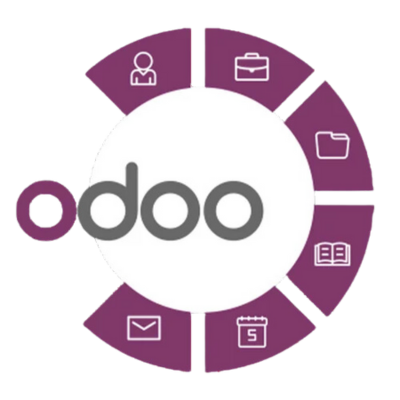Introduction
Odoo, an open-source ERP solution, is widely recognized for its flexibility, modularity, and cost-effectiveness. However, implementing Odoo in large enterprises comes with unique challenges. Unlike small to medium-sized businesses, large enterprises require complex configurations, extensive integrations, and high-level scalability to meet their operational demands. This guide explores the specific challenges large enterprises face when implementing Odoo, along with practical insights for overcoming these obstacles.

1. Scalability and Performance
Large enterprises typically handle high volumes of data and users, which can place significant strain on system resources. Ensuring Odoo’s scalability and maintaining optimal performance is crucial to support large-scale operations.
- Challenge of Data Volume: Managing large databases can slow down system performance and increase response times.
- User Management: High user concurrency may affect system performance if the infrastructure is not adequately prepared.
- Performance Optimization: Implementing necessary optimizations to handle increased load can be complex and time-consuming.
Solution: To enhance scalability, enterprises may need to invest in dedicated servers or cloud solutions, ensuring adequate storage and processing power for high volumes of data and user activity.
2. Customization Complexity

Large enterprises often have specific needs that require advanced customization. However, the more complex the customization, the more challenging it becomes to manage updates and ensure stability.
- Custom Module Development: Developing custom modules to meet unique business requirements can require specialized expertise and development resources.
- Compatibility Issues: Customizations may affect compatibility with future Odoo updates, leading to maintenance challenges.
- Balancing Customization with Stability: Excessive customization can complicate troubleshooting and affect the stability of the entire system.
Best Practice: Limit customization to essential features and work with experienced developers to create robust, well-documented custom modules that are easier to update and maintain.
3. Data Migration and Integration
Data migration from legacy systems and integration with existing tools is critical for large enterprises but poses significant challenges. Moving large volumes of data while maintaining data integrity can be resource-intensive and complex.
- Legacy System Migration: Transferring data from outdated systems to Odoo requires careful planning and validation to avoid data loss.
- Integration with Other Software: Large enterprises often use multiple specialized tools, requiring seamless integration with Odoo for smooth operations.
- Data Quality Assurance: Ensuring data accuracy and consistency during migration is essential to avoid future operational issues.
Solution: Employ data migration specialists and integration consultants who can create tailored solutions for smooth data transition and compatibility with other enterprise systems.
4. User Training and Change Management
Implementing a new ERP like Odoo across a large organization requires comprehensive user training and change management to ensure successful adoption. Resistance to change and unfamiliarity with Odoo’s functionalities can hinder implementation.
- Comprehensive Training Needs: Training a large workforce on new processes and functionalities can be time-consuming and costly.
- Resistance to Change: Employees accustomed to legacy systems may resist adapting to a new platform, impacting productivity.
- Ongoing Support: Continuous support and refreshers may be needed to reinforce learning and maximize adoption.
Stat: Companies that invest in robust change management programs report a 30% increase in user adoption compared to those with limited training initiatives.
5. Compliance and Security

Large enterprises must comply with stringent regulatory requirements and data security standards. Ensuring Odoo meets these compliance and security requirements is essential to protect sensitive information and maintain customer trust.
- Data Security: Large enterprises often handle vast amounts of sensitive data, requiring strict security measures.
- Compliance with Regulations: Industries like finance, healthcare, and manufacturing must comply with regulations such as GDPR, SOX, and HIPAA.
- Access Control: Implementing role-based access control and maintaining audit trails is crucial for large-scale security management.
Solution: Use Odoo’s advanced security features, such as encryption and access control, and work with compliance experts to ensure that the implementation aligns with industry standards and regulatory requirements.
6. Project Management and Timeline Constraints
Implementing Odoo in large enterprises often involves lengthy project timelines, requiring strong project management to stay within budget and on schedule. Delays and unexpected costs can disrupt operations and strain resources.
- Resource Allocation: Allocating resources across departments while managing day-to-day operations can be challenging.
- Timeline Extensions: Large-scale odoo implementation services may exceed projected timelines, affecting costs and planning.
- Stakeholder Coordination: Coordinating between multiple stakeholders, including management, IT, and external consultants, requires careful oversight.
Stat: Companies that use structured project management techniques report a 20% reduction in implementation time and improved adherence to budgets.
Supercharge Growth with Odoo Experts!
Tailored Odoo Solutions for Streamlined Business Efficiency and Growth

Conclusion
While Odoo offers a powerful ERP solution with flexibility and cost advantages, implementing it within a large enterprise setting requires careful planning and consideration of the unique challenges involved. By addressing scalability, customization, data migration, user training, compliance, and project management, large enterprises can maximize Odoo’s potential and enjoy streamlined operations, enhanced efficiency, and regulatory compliance. For enterprises ready to navigate these challenges, Odoo provides the tools and flexibility to support large-scale growth and long-term success.
Realated Blogs
FAQ's
What Are The Common Pitfalls In Odoo Implementation?
Some common pitfalls during Odoo implementation include:
- Inadequate Requirement Analysis – Not understanding business needs before implementation.
- Over-Customization – Modifying Odoo beyond what is necessary can increase complexity and cost.
- Data Migration Issues – Poor data quality or incomplete data transfer.
- Lack Of User Training – Failure to properly train employees can lead to resistance and inefficiency.
- Underestimating Time And Budget – Unrealistic expectations regarding project timeline and costs.
How Can A Business Avoid Inadequate Requirement Analysis?
To avoid inadequate requirement analysis:
- Involve Key Stakeholders – Ensure all departments provide input for a comprehensive understanding of needs.
- Create A Detailed Scope – Define exact goals and expectations for the project.
- Conduct Workshops And Surveys – Gather insights from end-users to ensure the system will meet their needs.
- Prioritize Critical Features – Focus on essential features first to prevent feature creep.
What Are The Risks Of Over-Customizing Odoo, And How Can They Be Avoided?
Over-customization can lead to:
- Increased Costs – Customization requires time, effort, and money.
- Complexity In Maintenance – Custom features can make future updates difficult.
- User Adoption Issues – Excessive customization can make the system harder for users to navigate.
To avoid these risks: - Stick To Standard Features – Use out-of-the-box functionality whenever possible.
- Evaluate Customizations Carefully – Only implement custom features when absolutely necessary.
How Can Data Migration Issues Be Prevented During Odoo Implementation?
To prevent data migration issues:
- Cleanse Data Before Migration – Remove duplicates, outdated entries, and errors from legacy systems.
- Plan Data Mapping – Ensure that data from the old system is correctly mapped to Odoo’s format.
- Test Migration – Conduct trial migrations to identify issues before full data transfer.
- Backup Data – Always have backups in case something goes wrong during the migration process.
What Strategies Can Be Used To Ensure Proper User Training In Odoo Implementation?
To ensure proper user training:
- Train Early and Often – Start training sessions early and provide regular refresher courses.
- Create Custom Training Materials – Tailor materials based on the user’s department and role.
- Involve Key Users – Train power users who can help others post-implementation.
- Provide Hands-On Experience – Allow users to practice using the system in real scenarios.
- Offer Ongoing Support – Ensure users can access help after implementation through support teams or resources.




